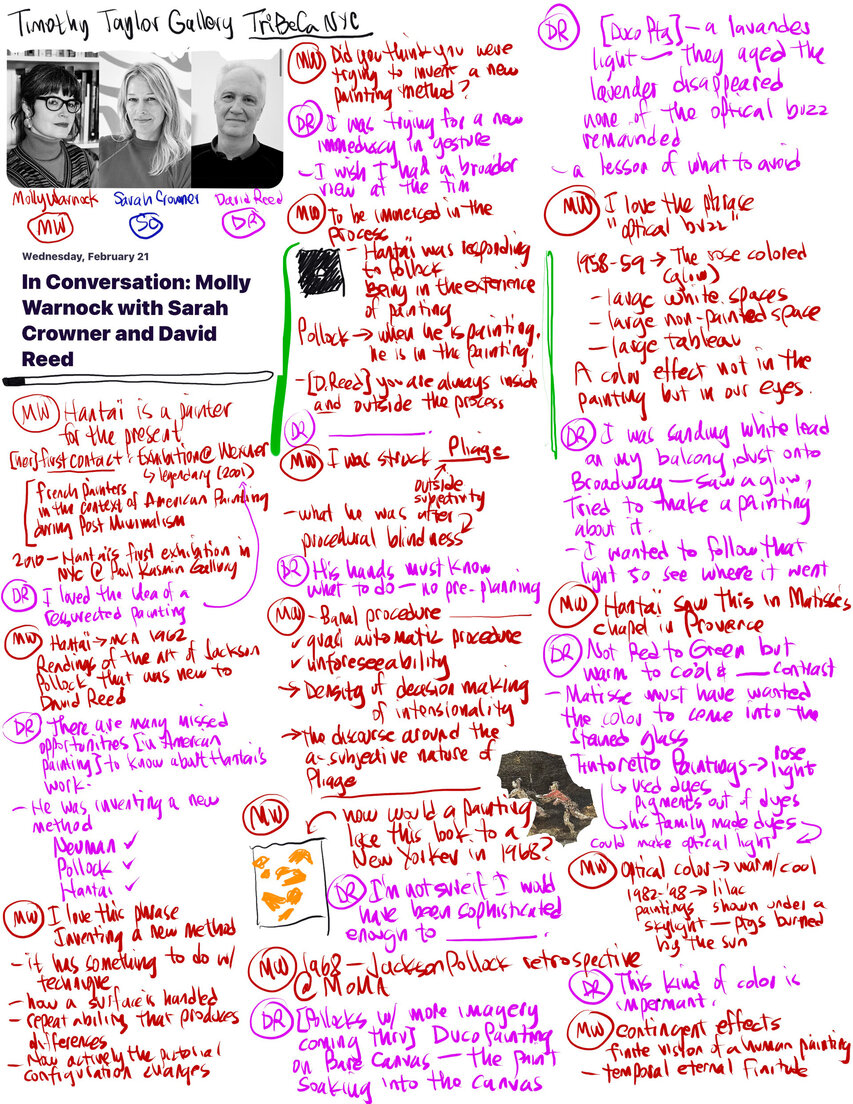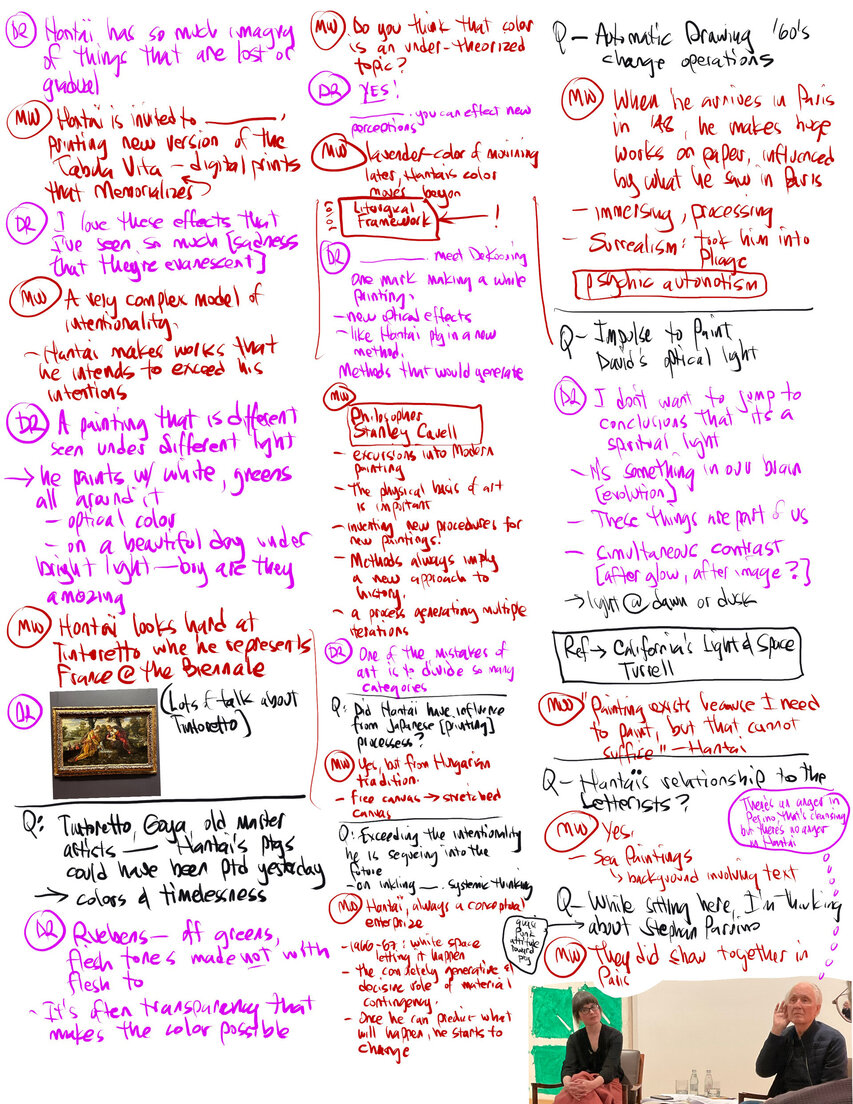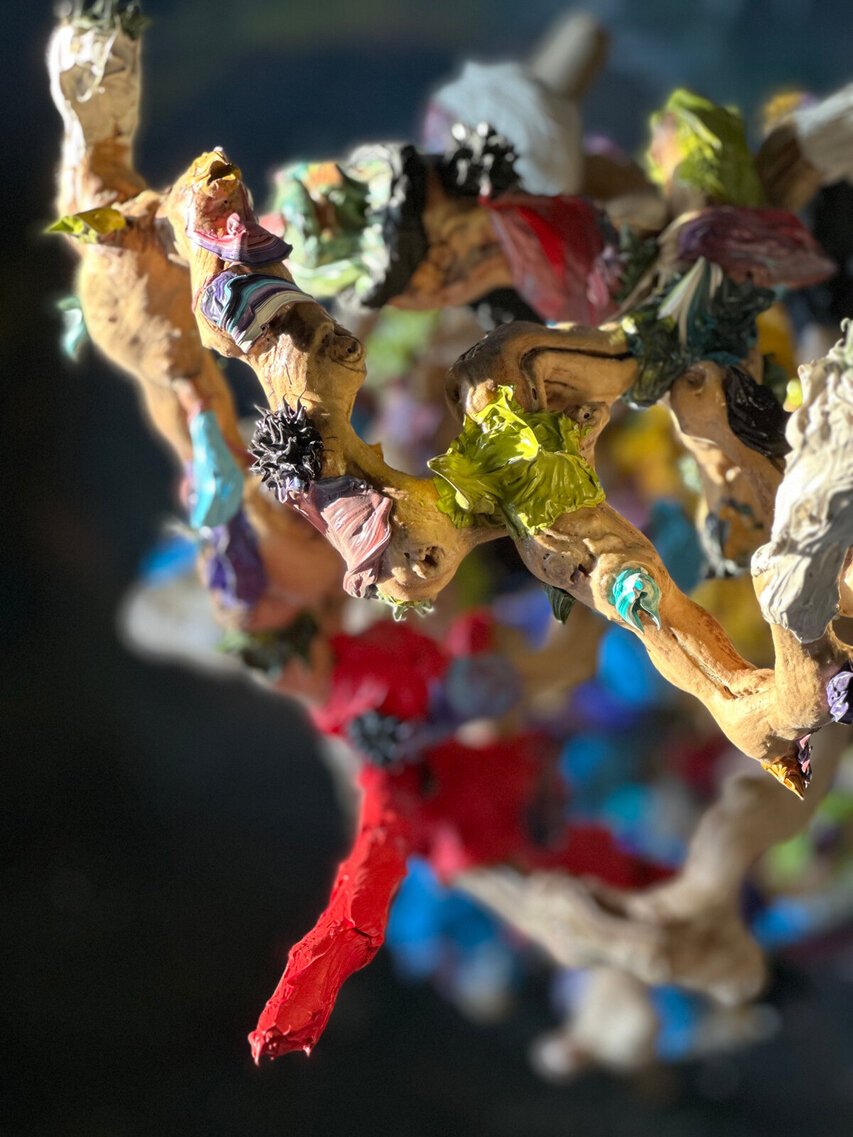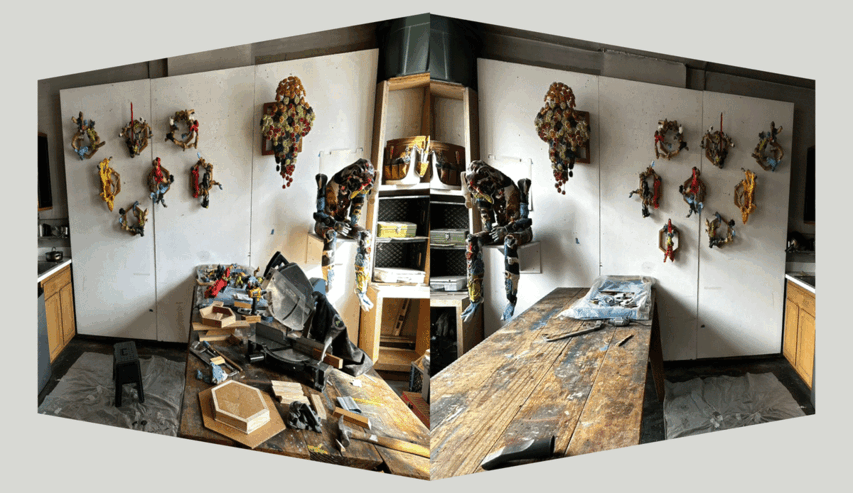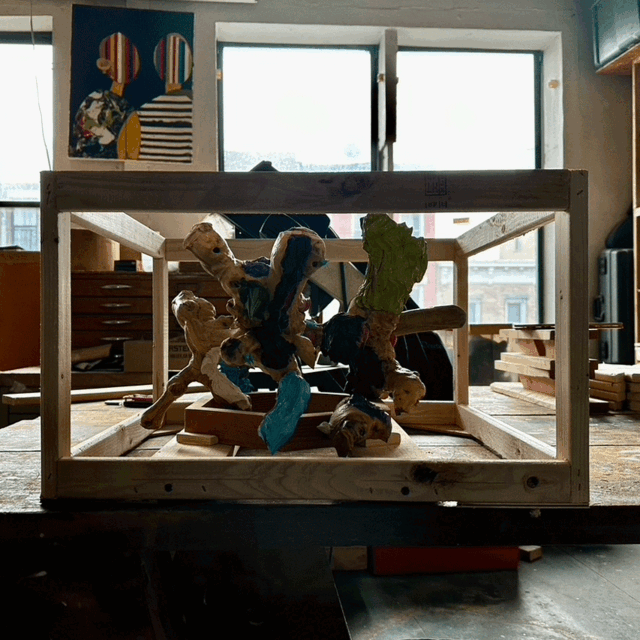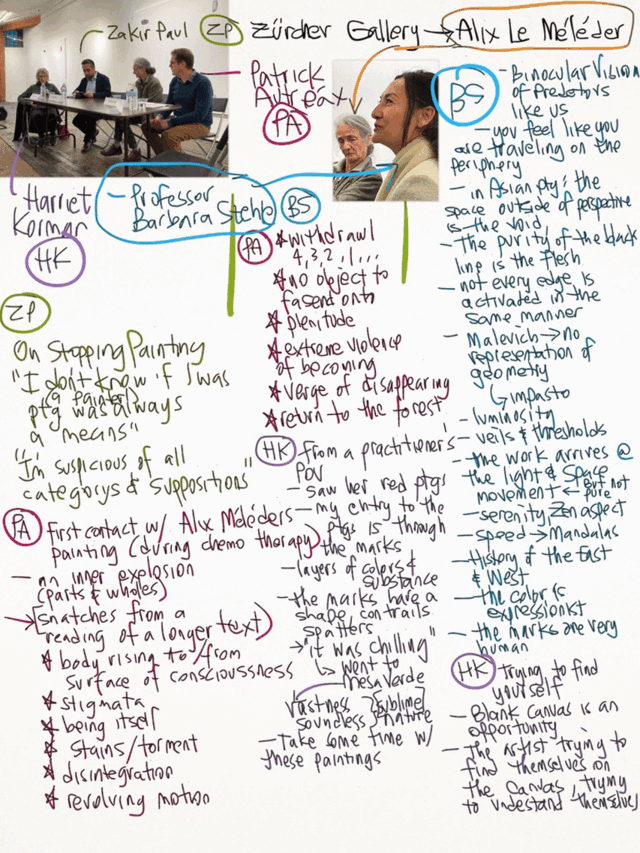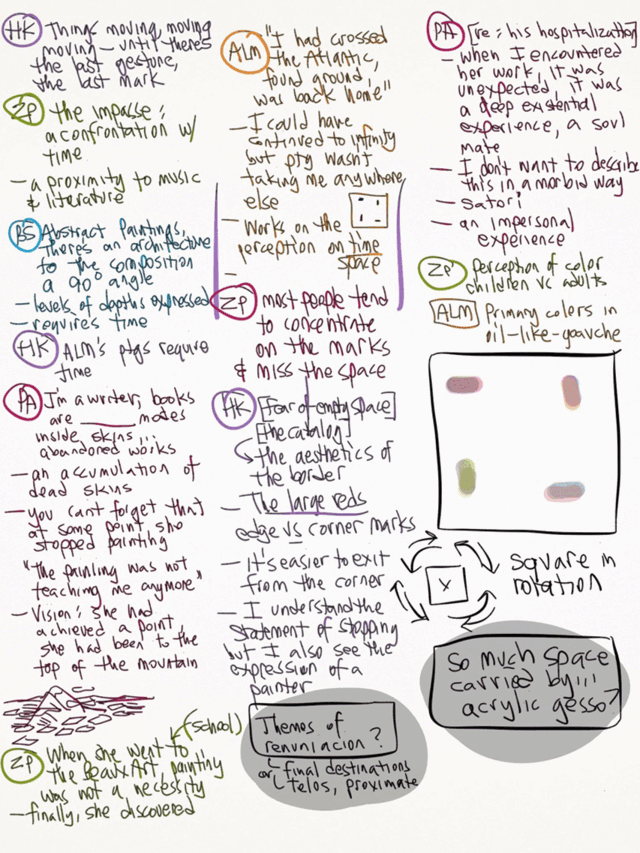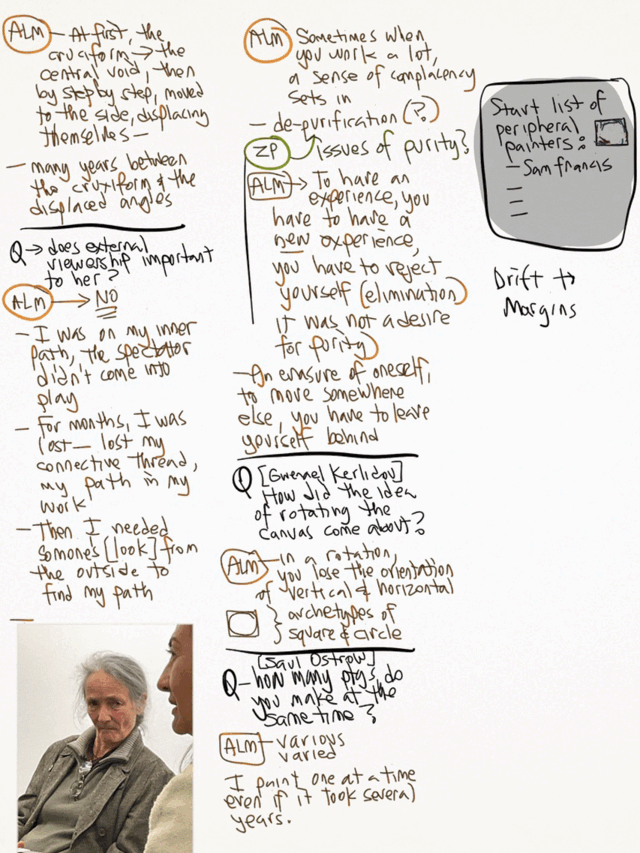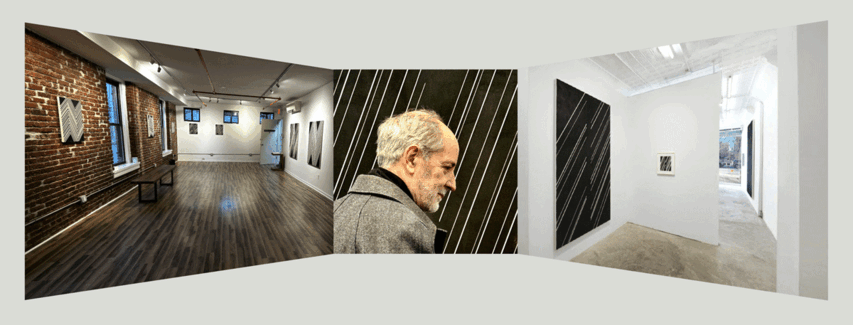February 22, 2024
Panel Discussion: Hantaï at Timothy Taylor Gallery
A few thoughts after the event:
First of all, it was delightful to have two heavyweights, one a historian of contemporary art and an esteemed New York painter, possessing his own unique pictorial language and a powerful oeuvre. The audience was full of smart talented artists.
Two topics were dominant in the room that night. Warnock dealt out the allover card and Reed, the color card. Via the allover, Warnock connected Hantaï to Pollock's drip painting* (via Neuman's zip painting, extending the lineage). She is known for her expertise in European painting but there's an interesting line item in her bio that goes like this: "...Director of the Clyfford Still Catalogue Raisonné Project at the Clyfford Still Museum in Denver, Colorado". So, she's steeped in the high water mark of New York Abstraction of the 50's and 60's.
Listening to Warnock's introduction, my impression was that issues of materiality and scale is the thrust of her concerns. Flipping through books on Hantaï (Warnock had just published one recently), black and white photographs of Hantaï in the studio are quite impressive. Evidently, Hantaï found studios in abandoned factories, the scale of canvas measure ten, twenty, thirty feet it seems, covering crumbling walls and floors. This was the post war era when populations were migrating from cities to suburbs, factories were retooling for peacetime, immense spaces were available to artists for the first time in history. This, coinciding with the emerging market booming consumer economy and the technological acceleration due to wartime innovation, you have the three significant drivers for post war abstract art.
As an artist who is heavily invested in letting materiality drive painting, the medium long since declared defunct and dead after the Pop/Minimalist/Conceptualist/Postmodernist carried forward Duchamp's Telegram (wink, de Duve, his new book that I'm currently reading), I was delighted to hear Warnock call for a new push for painting that focused on materiality. The thing is, such a project has to be cautious and mindful of what had happened in the long meantime.
Color was the other theme of the night. Reed talked about optical color, that color not in the world but in the retina or cerebral cortex. Or, maybe it's in the world but it's fugitive... Reed lamented that Pollock's use of Duco paint rendered a lovely lavender light that disappeared after the painting aged out. The words "optical color" resonated in the audience and subsequent discussion prompted me to reflect on California's Light and Space movement, James Turell and Robert Irwin specifically. Strange to hear New Yorkers lilt so many years after that era.
Yes, a very nice evening. Warnock, launching salvos like "...contingent effect... the finite vision of a human painting... the temporal eternal finitude..." and Reed, delicately savoring color, speaking of Tintoretto and Rubens.
*
*
*
NB: Regarding Pollock, I'm reading Carter Radcliff's book, a project commissioned by the Pollock/Krasner Foundation, apparently. You can read it here.
NG2: Coincidentally, I visited the Met's newly rennovated European Wing. It was delightful. Of the pics I snapped, Tintoretto caught my attention. Nice to hear Reed drop his name.

Panel Discussion: Alix Le Melédér at Zürcher Gallery
Alix Le Méléder, Paintings 1998-2011, January 16- February 28, 2024, at Zürcher Gallery, New York
Snips from the press release:In Alix le Méléder' s work, for every action there appears a requisite result of restraint or a negation. ... Alix stopped painting in July 2011. She had completed her work. The ethical and philosophical nature of her decision to stop painting comes from her work's internal logic. Alix could typically go on working but it would be meaningless. She felt she had nothing else to say, so echoing Herman Melville's Bartleby, she says "I'd prefer not to". Alix Le Méléder comments :
I realized one day that there was a desire for expression in my paintings and I wanted to free myself from it. I had to erase myself and paint again with color. I felt the need to blow out the space even more, that's why I came to the square format. And then to escape a kind of horizontal face to face with the canvas, I decided to rotate it."
This is my first exposure to le Méléder's painting, it was fortunate to be able to attend the panel discussion on such an occasion. Much of the press release is in the artist's own voice, it was a challenge to find the transition between the gallery's words and hers. I'm not sure why this is significant, but a comment about it feels necessary right now. Evidently, le Méléder spent a lot of time in India and has absorbed Hindu and Buddhistic philosophy to a serious degree. As a result apparently, she glories in the extinction of desire, self, and the liberation of the legendary cycle of death and rebirth.
From my perspective, within the lens of her life, oeuvre and personality, she had recapitulated the theatrical eschatological death wish inherent in Modernity, in both manifestations Modern and Postmodern... a turn of the volume knob on the control panel of painting. Click, click, click until the final snap that powers down the unit off. Painting is her vehicle to a destination called satori. Once she got there, she didn't need the taxicab anymore.
Here's the last lines of the press release in the voice of the artist:
I felt all along the way a great closeness to India in my relationship to the world, to life and to nature; Painting took me on a kind of initiatory journey with its experiences and obstacles, with its phenomena that brought me to awareness. Each step of this journey had to be based on knowledge and not on a simple intuition. These paintings are the manifestations of a phenomenon of shifting consciousness between death or non-being and birth or re-birth. To reach this state, I had to work on a negation of myself, a kind of annihilation, a necessary passage to go towards the unknown.
February 3, 2024
David Rhodes, Doubled
David Rhodes | Aletheia , January 18 - March 3, 2024 HIGH NOON GALLERY, 124 Forsyth Street, NYC
David Rhodes | Partita , January 26 - March 1, 2024 HELM CONTEMPORARY, 132 Bowery, NYC
This is a great NYC month for my friend David Rhodes. Two solo exhibitions are up centering on David's paintings are up in the galleries of NYC this month. This is on the heels of a fine group exhibition that he was included in, Beyond the Surface, Westbeth Gallery, New York. A great painter, fine writer, a sensitive soul. David included me in a group exhibition at Hionas Gallery when I first moved to NYC in 2012-13. I met Peter Hiionas and consequently met the artists orbiting his space, a group of intelligent and committed artists all.
"David Rhodes: Reconfiguring the authorship of a painting", Two Coats of Paint, by Adam Simon
"David Rhodes: Alethia", The Brooklyn Rail, by Saul Ostrow
The other day while enroute to my studio in Brooklyn via the D Train, I was thinking about how this moment was special for David, of how we can see David's overall painting endeavors in a dimensional way because of the several venues that now feature his work. So I wrote the following thoughts out. I'm pasting them raw without any edits or refinements.
On The Two Rhodes Exhibitions
*
*
*
"He was a sceptic, he was young, abstract, and therefore cruel."
― Fyodor Dostoyevsky, Crime and Punishment
*
*
*David Rhodes is not young
Is David Rhodes a skeptic?
David Rhodes is an abstractionist.
David Rhodes is gentle.Alethia: uncovering (truth?) revealing? The subtleties of Heidegger, uncovering the blind side of the Western psyche. The central motif in the High Noon exhibition is the space slicing vertically (and of course diagonally, a constant instrument in his paintings), a parting of curtains, a reveal. Is what is being disclosed is actually "The Origin of the Work of Art"? This suggestion is heavy. Is the clearing for the appearance of things in their world, a setting of a stage?
Partita: music composition, originally referring to a single instrument, Bach used it as a synonym for a suite, a collection.
One, a parting. The other, a gathering.
One, a revelation. The other, an interweaving, a society.The intervals between lines, the thicknesses of lines: we see how they range from edge to edge, we see the frequency, but a pattern among them is elusive. It suggests a signal but resists a decoding. The pattern of lines suggest frequency and frequency suggests waves. A two slit experiment suggests an observer is present, waves collapsing into particles, particles acting in concert as waves.
The ground is as noumemal as a Malevich black square. It is as if we have fallen into the Last Future. (Zero Ten.) The blackness is velvety, there is no color change from one canvas to the next except for a certain shine and a shifting palpable quality. The eyelids close with not even an afterimage in sight... or alternatively, the rays across the inky depth are flashes of an optic nerve. Two moments before and after the performance: first, the silence before the spotlight alights and second after the applause dies. Both are inky black. Both are full of what is to come and what had been.
*
*
*
PPS: More thoughts arise. An artesian well, Rhodes' work is.
Two categories follow, the issue of representation and abstraction and "fit for purpose":
Rhodes' painting is simultaneously presenting (representational) and non-presenting (abstraction). It is both at once like other things and its own thing. At what point is this simultaneity in balance and in conflict? At what point is this frozen? At what point is this a cunning entrapment? At what point is this abundance or depletion?
***
Form Follows Function, as the famous Modernist said. "Fit for purpose" is a British phrase I learned while binging BritBox. There's a classically Modernist economy of means operating in Rhodes' work. Tape goes down, paint splashed on, tape goes up.
Done.
No fat.
Lean.
* Numberless are the world's wonders / But none more wonderful than man / Words and thought rapid as air / He fashions for his use / And his the skill that deflects the arrows of snow / The spears of winter rain / From every wind he has made himself secure / From every wind he has made himself secure / From all but one ... / all but one / In the late wind of death he cannot stand
